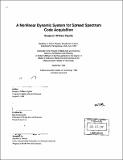| dc.contributor.advisor | Neil Gershenfeld. | en_US |
| dc.contributor.author | Vigoda, Benjamin William, 1973- | en_US |
| dc.contributor.other | Massachusetts Institute of Technology. Dept. of Architecture. Program In Media Arts and Sciences. | en_US |
| dc.date.accessioned | 2011-05-23T17:51:33Z | |
| dc.date.available | 2011-05-23T17:51:33Z | |
| dc.date.copyright | 1999 | en_US |
| dc.date.issued | 1999 | en_US |
| dc.identifier.uri | http://hdl.handle.net/1721.1/62950 | |
| dc.description | Thesis (S.M.)--Massachusetts Institute of Technology, School of Architecture and Planning, Program in Media Arts and Sciences, 1999. | en_US |
| dc.description | Includes bibliographical references (leaves 88-89). | en_US |
| dc.description.abstract | Nonlinear differential equations and iterated maps can perform any computation. Sometimes, the most difficult part of performing a useful computation, however, is writing the program. Furthermore, in practice, we often need to build special purpose computing hardware suited to run a particular program. Nonlinear dynamics provides a novel and useful language for constructing "algorithms" and "computer architectures." We apply the language of nonlinear dynamics to solve a fast coding problem which has previously been implemented by a Digital Signal Processor chip in digital wireless receivers. We eventually hope to produce a novel physical system which exhibits the nonlinear dynamics we require, thereby creating one of the first nonlinear dynamic systems engineered to perform a practical computation. This system, called an Analog Feedback Shift Register (AFSR), should be a faster, more reliable, less expensive, and lower power Spread Spectrum (SS) code acquisition system for wireless receivers. A prohibitive factor in creating ubiquitous short range, digital radio transceivers is the difficulty and expense of creating a mechanism for locking onto the incoming Spread Spectrum code sequence. AFSR is also potentially useful in other applications where low cost, low power channel sharing or addressing is required, for example in wireless auto-identification tags. | en_US |
| dc.description.statementofresponsibility | by Benjamin William Vigoda. | en_US |
| dc.format.extent | 89 leaves | en_US |
| dc.language.iso | eng | en_US |
| dc.publisher | Massachusetts Institute of Technology | en_US |
| dc.rights | M.I.T. theses are protected by
copyright. They may be viewed from this source for any purpose, but
reproduction or distribution in any format is prohibited without written
permission. See provided URL for inquiries about permission. | en_US |
| dc.rights.uri | http://dspace.mit.edu/handle/1721.1/7582 | en_US |
| dc.subject | Architecture. Program In Media Arts and Sciences. | en_US |
| dc.title | A nonlinear dynamic system for spread spectrum code acquisition | en_US |
| dc.type | Thesis | en_US |
| dc.description.degree | S.M. | en_US |
| dc.contributor.department | Program in Media Arts and Sciences (Massachusetts Institute of Technology) | |
| dc.identifier.oclc | 48206793 | en_US |
